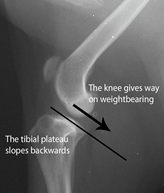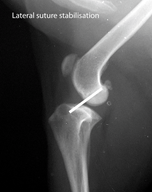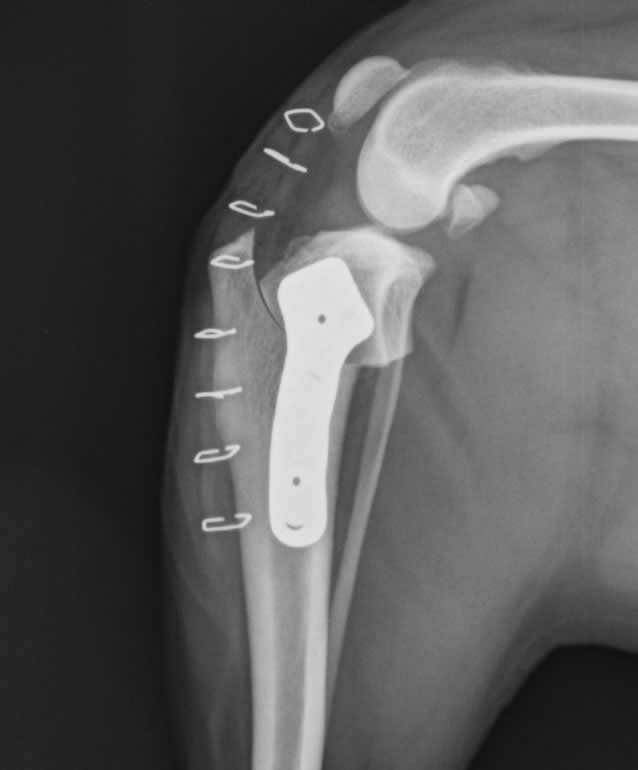Rupture of the (cranial) cruciate ligament is very common in dogs, less so in cats, and causes lameness and the development of osteoarthritis.
Why does it rupture?
The reason the cruciate ligament ruptures is usually not clear. Very few cases in dogs appear to result from injury, which is the usual cause in humans. Two major populations are seen in dogs: middle – aged dogs, where the ligament may just wear out due to age and young dogs, where certain features of anatomy, posture and gait possibly over – load the ligament, causing it to fail prematurely.
In over half of affected dogs, both stifles will become involved at some stage. The ligament may rupture suddenly, in which case lameness also develops suddenly or, more often, it gradually frays and may only partially rupture. This still causes pain and lameness.
What happens when the cruciate ligament ruptures?
 When the cruciate ruptures, due to the slope at the top of the tibia (the tibial plateau) abnormal sliding movement in the stifle is possible i.e. it “gives way” on weightbearing.
When the cruciate ruptures, due to the slope at the top of the tibia (the tibial plateau) abnormal sliding movement in the stifle is possible i.e. it “gives way” on weightbearing.
This is painful and produces a common clinical picture whereby, if exercise is limited, lameness is reduced but, if exercise is increased, lameness gets worse.
Muscle bulk on the front of the thigh is reduced and the stifle becomes swollen. Osteoarthritis always develops to some extent.
How do we diagnose it?
The abnormal movement in the joint can usually be detected on examination (although sometimes only under sedation or anaesthesia, so that the leg muscles are relaxed). X-rays cannot see the ruptured ligament, but do show the changes of osteoarthritis.
 Some dogs can recover spontaneously, but usually only if they weigh less than 12 – 15kg. West Highland White terriers are a common exception to this rule. Spontaneous recovery can take 2-4 months. Larger dogs rarely cope well without surgery.
Some dogs can recover spontaneously, but usually only if they weigh less than 12 – 15kg. West Highland White terriers are a common exception to this rule. Spontaneous recovery can take 2-4 months. Larger dogs rarely cope well without surgery.
The ruptured ligament cannot be replaced successfully, so surgery usually involves either placing a band of synthetic material along the side of the joint to take over the cruciate ligament’s function (lateral suture stabilisation (LSS)) or changing the way that the knee works so that the cruciate ligament is not needed by making a radial (semi-circular) osteotomy (cut in the bone) just below the knee and rotating the tibial plateau to level it so that the knee no longer gives way (tibial plateau levelling osteotomy (TPLO)).
The osteotomy is stabilised using a specially-shaped steel plate and screws.
TPLO is the preferred option in most dogs
What’s the outcome of treatment?
 The majority of dogs recover well following appropriate treatment of cruciate rupture, although full convalescence can take 3-4 months. All will develop osteoarthritis to some degree although this only compromises function if severe.
The majority of dogs recover well following appropriate treatment of cruciate rupture, although full convalescence can take 3-4 months. All will develop osteoarthritis to some degree although this only compromises function if severe.
Most dogs will also suffer damage to the meniscal cartilages in the knee at some point, although that can usually be prevented or treated.
Where a high level of function is required (eg very active or working dogs) TPLO is more reliable than either non – surgical management or lateral suture stabilisation.
Unfortunately, in around 50% of dogs the cruciate ligament in the opposite knee will rupture at some point in the future.
© Andrew Miller & Associates 2016
Thank you to everyone at Broadley’s, especially Luke. My wee dog Rosie has had TPLO surgeries done on both her back legs, since the beginning of the year.
This has made such a difference to her mobility and she has started to enjoy playing with her toys again and going for her wee walk. Rosie has received excellent care from Broadley’s, the nurses and reception have been so helpful when we have been at the hospital and with Rosie’s aftercare.
Luke has been fantastic with Rosie and with his expertise, advice and the operations he did for Rosie, she is now pain free and is a happy wee dog again enjoying life.
I am truly grateful to Luke and the staff at Broadley’s for what they have done for Rosie.
Marie Terese Xx
Our dog Lady was seen by Andrew.
Very grateful for all care given to our furbaby and counting down the weeks until she can be off the lead and running around crazy again.
We hope not to see you again but know that if we do our girl will be great hands. The photo of Lady shows her with a big smile at being able to go swimming again because of Andrew’s fantastic work.
Donna
Our beagle Alfie was recommended to go here from our own vets in Glasgow as Alfie needed surgery on his leg.
So we met with one of the vet surgeons who took Alfie in for xrays n spoke to us about the options. Andrew n his team completed both parts of the TPLO surgery on Alfie around 2 and a bit years ago.
I’d like to say thank u to everyone in Broadleys for helpin us arrange the stuff with the insurance company and lookin after my dog…. Alfie is now happy and ud never know he had the surgery got a lot mire energy in him now!
Mandy
Orthopaedic Referral Service
Our orthopaedic service, with state-of-the-art facilities, including MRI and CT scanning, and expert nursing care, provides the highest level of veterinary orthopaedic care available.
We use the highest quality equipment and perform minimally invasive techniques where appropriate from Chihuahuas to Great Danes.
We have special miniature fracture systems for cats and small dogs.

